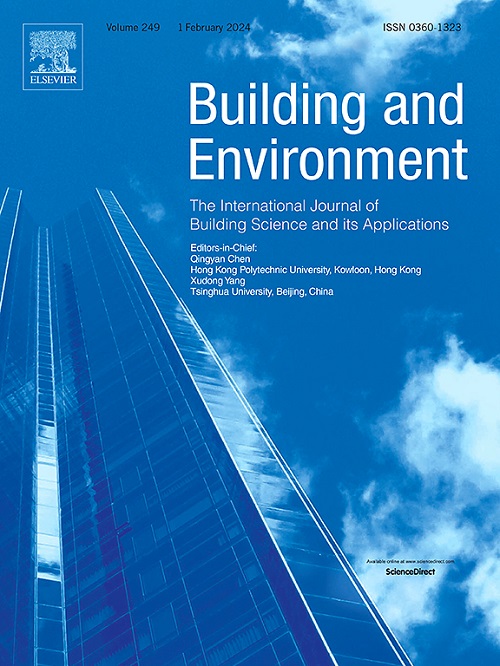Indoor moss biomonitoring proving construction-related pollution load from outdoors
IF 7.1
1区 工程技术
Q1 CONSTRUCTION & BUILDING TECHNOLOGY
引用次数: 0
Abstract
Indoor pollution load in an office environment was investigated during ongoing construction works in the vicinity using the wet moss biomonitoring technique. Monitoring boxes were placed inside eight offices with mechanical ventilation located on three floors and with four different orientations to outdoor construction works for 8 weeks. Samples were collected every two weeks for two months, and the concentrations of selected elements: Al, As, Ca, Cd, Cr, Cu, Fe, Mg, Mn, Pb, Si and Zn were determined. Total deposition (composition, number and size of particles) was determined in the samples too. Correlation analysis complemented by Principle Component Analysis (PCA) was performed using a compositional approach. Concentrations correlated significantly among crustal elements and among road dust elements. PCA identified three groups of elements – representing construction dust, traffic origin and indoor origin, while those associated with construction dust had the highest contribution. The elevation (floor) affected the composition of the samples the most, the orientation to the pollution sources was secondary. Construction dust was most dominant on the 1st floor; samples from the sheltered sites were negatively associated with construction dust elements; here, the finest particles were also observed. Starting at 6 weeks of exposure, construction dust elements started to dominate in samples. Construction dust is a serious pollution problem, and its infiltration from the outdoors is apparent even in mechanical-ventilated indoor environments. Moss indoor monitoring technique was proven to be a suitable cost-effective alternative to automatic air samplers in determining the outdoor-originating pollution loads indoors.
室内苔藓生物监测证明与施工有关的室外污染负荷
采用湿苔生物监测技术调查了附近正在进行的建筑工程期间办公环境的室内污染负荷。监测箱被放置在三层楼的八间带机械通风设备的办公室内,与室外建筑工程有四个不同的朝向,为期八周。在两个月的时间里,每两周收集一次样本,并测定选定元素的浓度:测定了铝、砷、钙、镉、铬、铜、铁、镁、锰、铅、硅和锌。此外,还测定了样本中的总沉积物(颗粒的成分、数量和大小)。采用成分分析法进行了相关性分析,并辅以主成分分析法(PCA)。地壳元素之间和道路尘埃元素之间的浓度有明显的相关性。主成分分析确定了三组元素--分别代表建筑尘埃、交通尘埃和室内尘埃,而与建筑尘埃相关的元素所占比例最高。海拔(楼层)对样本成分的影响最大,而污染源的方位则次之。建筑尘埃在 1 楼最为常见;来自遮蔽场所的样本与建筑尘埃成分呈负相关;在这里,也能观察到最细的颗粒。从暴露 6 周开始,建筑尘埃开始在样本中占主导地位。建筑粉尘是一个严重的污染问题,即使在机械通风的室内环境中,其从室外渗入的现象也很明显。事实证明,在确定室内源于室外的污染负荷方面,Moss 室内监测技术是自动空气采样器的一种经济有效的替代品。
本文章由计算机程序翻译,如有差异,请以英文原文为准。
求助全文
约1分钟内获得全文
求助全文
来源期刊

Building and Environment
工程技术-工程:环境
CiteScore
12.50
自引率
23.00%
发文量
1130
审稿时长
27 days
期刊介绍:
Building and Environment, an international journal, is dedicated to publishing original research papers, comprehensive review articles, editorials, and short communications in the fields of building science, urban physics, and human interaction with the indoor and outdoor built environment. The journal emphasizes innovative technologies and knowledge verified through measurement and analysis. It covers environmental performance across various spatial scales, from cities and communities to buildings and systems, fostering collaborative, multi-disciplinary research with broader significance.
 求助内容:
求助内容: 应助结果提醒方式:
应助结果提醒方式:


